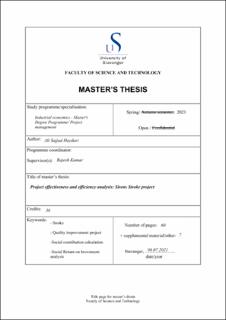| dc.description.abstract | Every year, approximately 12 000 people are admitted to Norwegian hospitals withstroke. In addition to being a frequent cause of death, stroke is a dominant causeof severe disability with great strain on patients, their relatives and society in general.The number of stroke patients is expected to increase parallel with more elderly peoplein the population. This, together with reduced mortality, means that the number of people living with sequelae after a stroke will increase significantly. It is therefore important to map the treatment offer and ensure that treatment and follow-up of this large patient group has been well taken care of.
”Time is Brain” is a catchphrase that explains why it is so important for people experiencing symptoms of a stroke to receive prompt care. A stroke occurs when a bloodvessel in the brain is either blocked or bursts. The longer the brain is deprived of oxygen-rich blood, the greater the chances of long-term disability and even death.
Sirens Stroke has worked systematically to reduce the door-to-needle time at Stavanger University Hospital since 2009. From 2014 onwards, a median door-to-needle time of less than 30 min was achieved. However, Sirens Stroke hypothesised that further improvement could be achieved through implementing a revised treatment protocol and in situ simulation-based team training sessions in a quality improvement project.This hypothesis proved to be true as a reduction in median door-to-needle time of 13 minutes was achieved. This reduction also lead to 6.36 deaths averted annually.
The objective of this thesis was to monetise and calculate Sirens Strokes social con-tribution through their quality improvement project. We used ”new economic foundation’s” guide to conduct a social return on investment analysis and calculated the social benefit to be 11 301 981.92 Norwegian kroner. The total cost of implementing and maintaining the quality improvement project added up to 426 655.67 Norwegian kroner which lead the total social return on investment to be 26.49. This indicates that every 1 Norwegian kroner invested delivered 26.49 Norwegian kroner in social value.
We showed that social return on investment analysis can be used in health relatedprojects and recommend Sirens Stroke and other non profit organizations to use thisanalysis method to convey heir social contribution. | |
